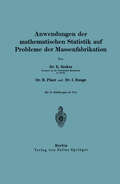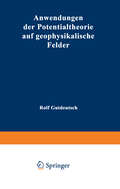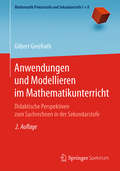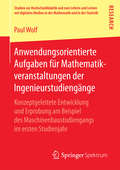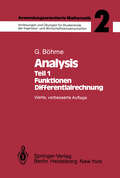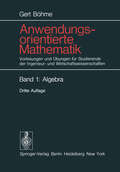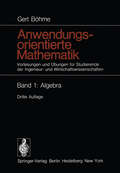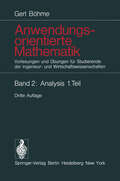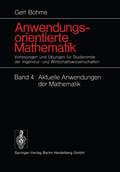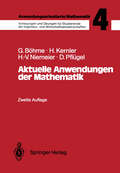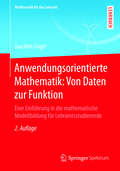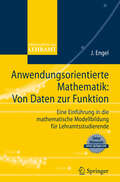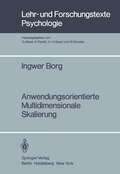- Table View
- List View
Anwendungen der mathematischen Statistik auf Probleme der Massenfabrikation
by Richard Becker H. Plaut I. RungeDieser Buchtitel ist Teil des Digitalisierungsprojekts Springer Book Archives mit Publikationen, die seit den Anfängen des Verlags von 1842 erschienen sind. Der Verlag stellt mit diesem Archiv Quellen für die historische wie auch die disziplingeschichtliche Forschung zur Verfügung, die jeweils im historischen Kontext betrachtet werden müssen. Dieser Titel erschien in der Zeit vor 1945 und wird daher in seiner zeittypischen politisch-ideologischen Ausrichtung vom Verlag nicht beworben.
Anwendungen und Modellieren im Mathematikunterricht: Didaktische Perspektiven zum Sachrechnen in der Sekundarstufe (Mathematik Primarstufe und Sekundarstufe I + II)
by Gilbert GreefrathDie in diesem Buch dargestellten Anwendungen prägen den aktuellen Mathematikunterricht der Sekundarstufe. Didaktische Perspektiven zum Sachrechnen und das mathematische Modellieren sind eine wichtige Grundlage für die Lehrerbildung. Auch die aktuellen Bildungsstandards stellen prozessbezogene Kompetenzen wie das Modellieren in den Vordergrund. In diesem Lehrbuch lernen Sie aktuelle Sichtweisen auf Anwendungen im Mathematikunterricht vor dem Hintergrund des Sachrechnens und des mathematischen Modellierens kennen. Besonders ausführlich werden die vielfältigen Aufgabentypen eines anwendungsorientierten Mathematikunterrichts dargestellt und klassifiziert. Hier erhalten Sie auch viele Anregungen für den Unterricht. Einige typische Unterrichtsinhalte zu Anwendungen in der Sekundarstufe wie Zuordnungen von Größen und der Einsatz digitaler Werkzeuge runden den Band ab. Das Buch wendet sich an Lehramtsstudierende, Referendarinnen und Referendare sowie Lehrkräfte mit Mathematik als Fach.
Anwendungsorientierte Aufgaben für Mathematikveranstaltungen der Ingenieurstudiengänge: Konzeptgeleitete Entwicklung und Erprobung am Beispiel des Maschinenbaustudiengangs im ersten Studienjahr (Studien zur Hochschuldidaktik und zum Lehren und Lernen mit digitalen Medien in der Mathematik und in der Statistik)
by Paul WolfPaul Wolf entwickelt und erprobt einen neuen Typ von Anwendungsaufgaben für die Service-Veranstaltungen der Mathematik mit Fokus auf die Verbindung von Mathematik und dem eigentlichen Studienfach. Motiviert wurde die Arbeit durch die relativ hohe Abbruchquote in den Ingenieurs-Bachelor-Studiengängen, die unter anderem auf die Komplexität und Relevanz der Mathematikausbildung während des Studiums zurückzuführen ist. Trotz des speziellen Bezugs zum Maschinenbau lässt sich das Konzept auch auf andere Studiengänge (z.B. Elektrotechnik) übertragen. Der Autor evaluiert sein Konzept durch eine vollständige empirische Vergleichsstudie in mehreren Jahrgängen.
Anwendungsorientierte Mathematik: Band 2: Analysis I: Funktionen, Differentialrechnung (Springer-Lehrbuch #2)
by Gert BöhmeAnwendungsorientierte Mathematik: Vorlesungen und Übungen für Studierende der Ingenieur- und Wirtschaftswissenschaften
by Gert BöhmeAnwendungsorientierte Mathematik: Vorlesungen und Übungen für Studierende der Ingenieur- und Wirtschaftswissenschaften Band 1: Algebra
by Gert BöhmeAnwendungsorientierte Mathematik: Vorlesungen und Übungen für Studierende der Ingenieur- und Wirtschaftswissenschaften
by Gert BöhmeAnwendungsorientierte Mathematik: Vorlesungen und Übungen für Studierende der Ingenieur- und Wirtschaftswissenschaften Aktuelle Anwendungen der Mathematik
by Gert Böhme H. Kernler H.-V. Niemeier D. PflügelAnwendungsorientierte Mathematik: Band 4: Aktuelle Anwendungen der Mathematik
by Gert Böhme Helmut Kernler Hans-Volker Niemeier Dieter PflügelDieser Band rundet das dreibändige Lehrbuch ab, das aus Vorlesungen an der Fachhochschule Furtwangen/Schwarzwald hervorgegangen ist. Es enthält eine Auswahl mathematischer Anwendungen, die in den letzten Jahren - auch für die Praxis - immer mehr an Bedeutung gewonnen haben: Prognoseverfahren, Wortstrukturen, Automaten, Graphen und Bestandsoptimierung. Die einzelnen Kapitel können unabhängig voneinander gelesen werden. Sie bieten einen ersten, leicht lesbaren und auf die Bedürfnisse der Praxis zugeschnittenen Einstieg. Das Buch wendet sich daher nicht nur an Studenten, sondern auch an Interessierte im Berufsleben.
Anwendungsorientierte Mathematik: Eine Einführung in die mathematische Modellbildung für Lehramtsstudierende (Mathematik für das Lehramt)
by Joachim EngelGegenstand des vorliegenden Lehrbuches ist der Prozess des Anwendens von Mathematik. Im Mittelpunkt stehen dabei der Funktionsbegriff sowie mathematische Methoden zur Modellierung funktionaler Abhängigkeiten zwischen zwei Größen.Das Buch zeichnet sich durch folgende besondere Merkmale aus:Reale Daten als Grundlage für viele Modellierungen als eine wichtige Voraussetzung für einen authentischen und glaubwürdigen Unterricht an Hochschule und Schule.Einsatz von Technologie als Werkzeug zum Problemlösen und zur Illustrierung von Konzepten und Zusammenhängen.Vernetzung verschiedener Inhalte der Mathematik wie Elementare Funktionenlehre, Analysis, Stochastik, Lineare Algebra,Numerik.Detaillierte Ableitungen von Ergebnissen sowie Übungen und Fragen am Ende der einzelnen Kapitel mit teilweise ausgearbeiteten Lösungen und mit Lösungshinweisen helfen bei der Vertiefung des Stoffes.
Anwendungsorientierte Mathematik: Eine Einführung in die mathematische Modellbildung für Lehramtsstudierende (Mathematik für das Lehramt)
by Joachim EngelGegenstand des Lehrbuchs ist der Prozess des Anwendens von Mathematik. Im Mittelpunkt stehen der Funktionsbegriff sowie mathematische Methoden zur Modellierung funktionaler Abhängigkeiten zwischen zwei Größen. Das Buch zeichnet sich u. a. dadurch aus, dass reale Daten als Basis für viele Modellierungen dienen und dass verschiedene Gebiete der Mathematik wie etwa die Funktionenlehre und Analysis miteinander vernetzt werden. Detaillierte Ableitungen von Ergebnissen sowie Übungen und Fragen am Ende jedes Kapitels helfen bei der Vertiefung des Stoffs.
Anwendungsorientierte Multidimensionale Skalierung (Lehr- und Forschungstexte Psychologie #1)
by I. BorgAnyone Can Code: The Art and Science of Logical Creativity
by Ali Arya"Ali Arya guides you in a fantastic journey full of creativity in a coherent way that allows the traveler to learn and build up over the knowledge acquired in previous chapters until the reader accomplishes skills to develop solutions using programming." — Andrés A. Navarro Newball, Professor, Pontificia Universidad Javeriana, Cali, Colombia "An excellent book that teaches programming and software development the way it should be done: independent from a specific implementation language and focusing on the main principles that are fundamental and substantive to any kind of software production." — Marc Conrad, Principal Lecturer, University of Bedfordshire, Luton, UK Anyone Can Code: The Art and Science of Logical Creativity introduces computer programming as a way of problem-solving through logical thinking. It uses the notion of modularization as a central lens through which we can make sense of many software concepts. This book takes the reader through fundamental concepts in programming by illustrating them in three different and distinct languages: C/C++, Python, and Javascript. Key features: Focuses on problem-solving and algorithmic thinking instead of programming functions, syntax, and libraries Includes engaging examples, including video games and visual effects Provides exercises and reflective questions This book gives beginner and intermediate learners a strong understanding of what they are doing so that they can do it better and with any other tool or language that they may end up using later. Author Ali Arya is an Associate Professor in the School of Information Technology at Carleton University, Ottawa, Canada. He received his PhD in Computer Engineering from the University of British Columbia, Vancouver, Canada, in 2003. He has over 25 years of experience in professional and academic positions related to software development and information technology. He is passionate about computer programming that brings together logical and creative abilities.
Anyone Can Code: The Art and Science of Logical Creativity
by Ali Arya"Ali Arya guides you in a fantastic journey full of creativity in a coherent way that allows the traveler to learn and build up over the knowledge acquired in previous chapters until the reader accomplishes skills to develop solutions using programming." — Andrés A. Navarro Newball, Professor, Pontificia Universidad Javeriana, Cali, Colombia "An excellent book that teaches programming and software development the way it should be done: independent from a specific implementation language and focusing on the main principles that are fundamental and substantive to any kind of software production." — Marc Conrad, Principal Lecturer, University of Bedfordshire, Luton, UK Anyone Can Code: The Art and Science of Logical Creativity introduces computer programming as a way of problem-solving through logical thinking. It uses the notion of modularization as a central lens through which we can make sense of many software concepts. This book takes the reader through fundamental concepts in programming by illustrating them in three different and distinct languages: C/C++, Python, and Javascript. Key features: Focuses on problem-solving and algorithmic thinking instead of programming functions, syntax, and libraries Includes engaging examples, including video games and visual effects Provides exercises and reflective questions This book gives beginner and intermediate learners a strong understanding of what they are doing so that they can do it better and with any other tool or language that they may end up using later. Author Ali Arya is an Associate Professor in the School of Information Technology at Carleton University, Ottawa, Canada. He received his PhD in Computer Engineering from the University of British Columbia, Vancouver, Canada, in 2003. He has over 25 years of experience in professional and academic positions related to software development and information technology. He is passionate about computer programming that brings together logical and creative abilities.
Anyons: Quantum Mechanics of Particles with Fractional Statistics (Lecture Notes in Physics Monographs #14)
by Alberto LerdaParticles with fractional statistics interpolating between bosons and fermions have attracted considerable interest from mathematical physicists. In recent years it has emerged that these so-called anyons have rather unexpected applications, such as the fractional Hall effect, anyonic excitations in films of liquid helium, and high-temrperature superconductivity. Furthermore, they are discussed also in the context of conformal field theories. This book is a systematic and pedagogical introduction that considers the subject of anyons from many different points of view. In particular, the author presents the relation of anyons to braid groups and Chern-Simons field theory and devotes three chapters to physical applications. The book, while being of interest to researchers, primarily addresses advanced students of mathematics and physics.
Apartness and Uniformity: A Constructive Development (Theory and Applications of Computability)
by Douglas S. Bridges Luminiţa Simona VîţăThe theory presented in this book is developed constructively, is based on a few axioms encapsulating the notion of objects (points and sets) being apart, and encompasses both point-set topology and the theory of uniform spaces. While the classical-logic-based theory of proximity spaces provides some guidance for the theory of apartness, the notion of nearness/proximity does not embody enough algorithmic information for a deep constructive development. The use of constructive (intuitionistic) logic in this book requires much more technical ingenuity than one finds in classical proximity theory -- algorithmic information does not come cheaply -- but it often reveals distinctions that are rendered invisible by classical logic.In the first chapter the authors outline informal constructive logic and set theory, and, briefly, the basic notions and notations for metric and topological spaces. In the second they introduce axioms for a point-set apartness and then explore some of the consequences of those axioms. In particular, they examine a natural topology associated with an apartness space, and relations between various types of continuity of mappings. In the third chapter the authors extend the notion of point-set (pre-)apartness axiomatically to one of (pre-)apartness between subsets of an inhabited set. They then provide axioms for a quasiuniform space, perhaps the most important type of set-set apartness space. Quasiuniform spaces play a major role in the remainder of the chapter, which covers such topics as the connection between uniform and strong continuity (arguably the most technically difficult part of the book), apartness and convergence in function spaces, types of completeness, and neat compactness. Each chapter has a Notes section, in which are found comments on the definitions, results, and proofs, as well as occasional pointers to future work. The book ends with a Postlude that refers to other constructive approaches to topology, with emphasis on the relation between apartness spaces and formal topology.Largely an exposition of the authors' own research, this is the first book dealing with the apartness approach to constructive topology, and is a valuable addition to the literature on constructive mathematics and on topology in computer science. It is aimed at graduate students and advanced researchers in theoretical computer science, mathematics, and logic who are interested in constructive/algorithmic aspects of topology.
API Analytics for Product Managers: A Practical Handbook For Understanding Key Api Metrics That Can Help Your Business Grow
by Deepa GoyalUnderstand key API metrics that can help you grow your business
Api Analytics For Product Managers: A Practical Handbook For Understanding Key Api Metrics That Can Help Your Business Grow
by Deepa Goyal Kinnie LaneApi Testing and Development with Postman: A Practical Guide to Creating, Testing, and Managing Apis for Automated Software Testing
by Dave Westerveldostman enables the exploration and testing of web APIs, helping testers and developers figure out how an API works. With Postman, you can create effective test automation for any APIs. If you want to put your knowledge of APIs to work quickly, this practical guide to using Postman will help you get started. The book provides a hands-on approach to learning the implementation and associated methodologies that will have you up and running with Postman in no time. Complete with step-by-step explanations of essential concepts, practical examples, and self-assessment questions, this book begins by taking you through the principles of effective API testing. A combination of theory coupled with real-world examples will help you learn how to use Postman to create well-designed, documented, and tested APIs. You'll then be able to try some hands-on projects that will teach you how to add test automation to an already existing API with Postman, and guide you in using Postman to create a well-designed API from scratch. By the end of this book, you'll be able to use Postman to set up and run API tests for any API that you are working with.
APL Programs for the Mathematics Classroom
by Norman D. ThomsonThe idea for this book grew out of proposals at the APL86 con ference in Manchester which led to the initiation of the I-APL (International APL) project, and through it to the availability of an interpreter which would bring the advantages of APL within the means of vast numbers of school children and their teachers. The motivation is that once school teachers have glimpsed the possibilities, there will be a place for an "ideas" book of short programs which will enable useful algorithms to be brought rapidly into classroom use, and perhaps even to be written and developed in front of the class. A scan of the contents will show how the conciseness of APL makes it possible to address a huge range of topics in a small number of pages. There is naturally a degree of idiosyncrasy in the choice of topics - the selection I have made reflects algo rithms which have either proved useful in real work, or which have caught my imagination as candidates for demonstrating the value of APL as a mathematical notation. Where appropriate, notes on the programs are intended to show the naturalness with which APL deals with the mathematics concerned, and to estab lish that APL is not, as is often supposed, an unreadable lan guage written in a bizarre character set.
APL with a Mathematical Accent
by C.A. ReiterThis book should be of interest to mathematics scientists working in the areas of linear algebra, abstract algebra, number theory, numerical analysis, operations research and mathematical modelling.
APL with a Mathematical Accent
by C.A. ReiterThis book should be of interest to mathematics scientists working in the areas of linear algebra, abstract algebra, number theory, numerical analysis, operations research and mathematical modelling.
APL2 in Depth
by Norman D. Thomson Raymond P. PolivkaThis book is designed for people with a working knowledge of APL who would like to increase their fluency in the wide range of extra facilities offered by second-generation APL products. Although the primary product in view is IBM's APL2 as implemented on mainframe, PC and RS/6000, the language fea tures covered share considerable common ground with APL *PLUS II and Oyalog APL. This is a book about skills rather than knowledge, and an acquaintance with some variety of APL on the reader's part is assumed from the start. It is designed to be read as a continuous text, interspersed with exer cises designed to give progressively deeper insight into what the authors conceive as the features which have the greatest impact on programming techniques. It would also be suitable as a text-book for a second course in APL2, although experience suggests that most programming language learning is now by self study, so that this volume is more likely to provide follow-up reading to more elementary texts such as "APL2 at a Glance" by Brown, Pakin and Polivka. Material is discussed more informally than in a language manual - in this book textual bulk is in proportion to difficulty and importance rather than to the extent of technical details. Indeed, some APL2 extensions are not covered at all where the technicalities pose no great problems in understanding and can be readily assimilated from the language manuals.
